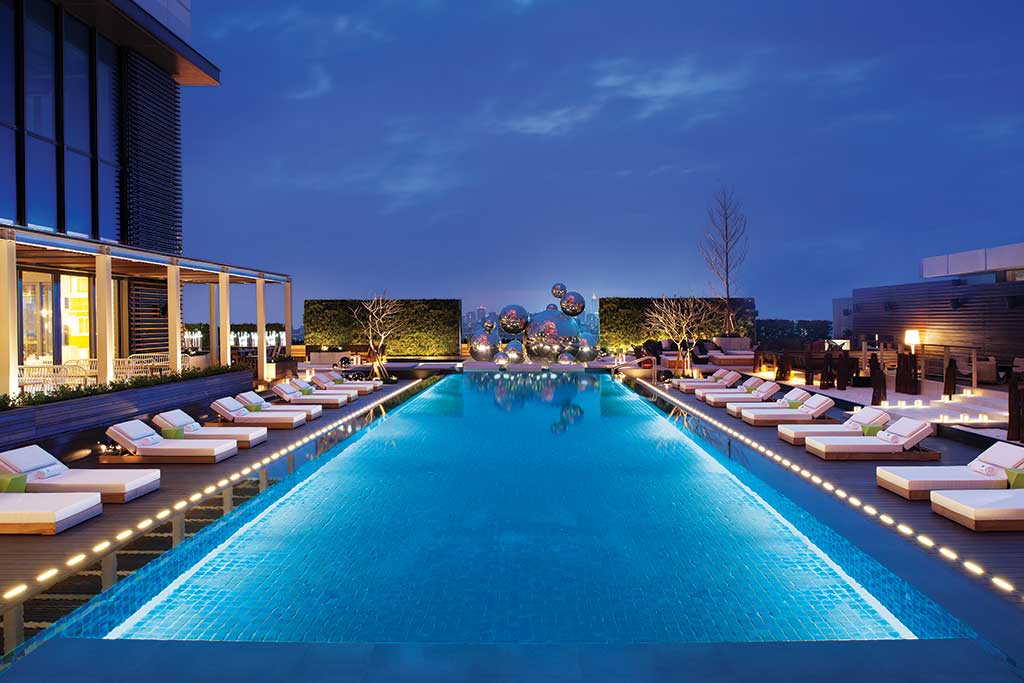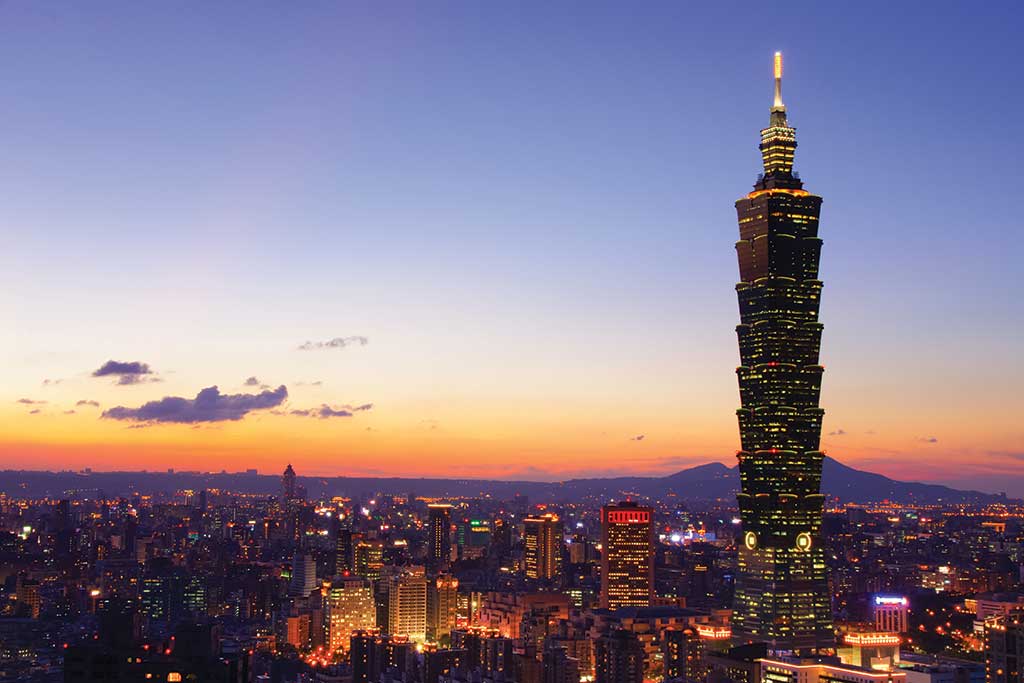Not so long ago, the label “Made in Taiwan” inferred mass-produced products that were made quickly, sold cheaply, and exported globally—typical fodder for our throwaway society. Then Taiwan made a seismic shift away from cheap, labor-intensive things like toys and textiles, to become the world’s biggest manufacturer of notebook computers.
A report in 2013 estimated that 89% of the world’s notebooks and 46% of desktop PCs were manufactured by Taiwanese companies, with global brands like Apple, Dell, Hewlett-Packard, and Lenovo utilizing Taiwan’s technological and creative talents. Taiwanese brands such as Acer, ASUS, and smartphone manufacturer HTC have also become major players.
This change isn’t restricted to hi-tech industries. Taipei, the capital city, has been named World Design Capital for 2016 by the ICSID (International Council of Societies of Industrial Design), a great honor for Taiwan’s growing design scene.
Amid the gleaming architecture of Taipei’s Xinyi financial district, a historic tobacco factory built in 1937 during the Japanese Imperial Era has become the Songshan Cultural and Creative Park, its modernist-style warehouses now converted into exhibition spaces, cafés, and design studios. Here, you’ll find the Taiwan Design Museum, whose galleries showcase the best of Taiwanese and international design, including recipients of the Golden Pin Design Award, a mark of innovative Taiwanese design that’s been awarded to products including bikes, teapots, and computer disk drives.
As sleek and polished as a HTC One smartphone, Xinyi is dominated by Taipei 101, a landmark skyscraper that was officially classified as the world’s tallest when completed in 2004, a title it retained until 2010. It nev- ertheless remains the world’s tallest green building, as certified by the US Green Building Council’s LEED (Leadership in Energy and Environmen- tal Design) rating system.
Much of this skyscraper’s structural design was influenced by traditional Chinese culture. It features eight canted segments of eight floors each, inspired by the Chinese lucky number ‘8,’ which sounds like the Chinese word for wealth and prosperity. This segmented design also means that Taipei 101 resembles a stalk of bamboo, a symbol of everlasting strength, although some critics have joked that it actually resembles a stack of Chi- nese takeout boxes.
Visitors may enjoy panoramic views from indoor and outdoor observation decks on the 88th and 91st floors of Taipei 101. It’s also an impressive centrepiece to the city’s New Year’s Eve fireworks display.
Nearby is W Taipei, a cosmopolitan five-star hotel with 405 guestrooms, popular with gay visitors and locals alike. This towering hotspot is literally chained to the ground: guests arriving at street level will notice gigantic links of chain, a detail added by the architect because he feared the hotel was so hot and happening that, if left unrestrained, it might take off into space!
The tenth-floor swimming pool deck and WET Bar is a hub for daytime Speedo-clad action, so grab a deckchair and a cocktail and enjoy sweeping city views. This landscaped oasis becomes super-chilled once the sun has set. Other happening spots include WOOBAR, a stylish lounge that pulsates to club beats with guest DJs at night. Signature cocktails include the Taipei Mule (Taiwan sorghum liquor, osmanthus flower sugar syrup, and ginger beer) and The Buddha’s Hand (green tea-infused Belvedere vodka, lemoncello, bergamot purée, lime, and honey), or you may prefer a bottle of 5BEER, crafted exclusively for W Taipei by North Taiwan Brewery.
W boutique showcases signature W products alongside goods by Taiwanese designers. These include a stylish and sustainable red jewelry tree made from recycled ABS, designed by Fanny Kuo as part of a “Trash Re- design” project by W Taipei and Taiwan Design Center. Among the fashion options are party dresses by gay Taiwanese-Canadian designer Jason Wu, whose fans include Michelle Obama and RuPaul.

W Taipei Pool
As well as being an emerging design champion, Taiwan is also a significant advocate of LGBT rights in Asia. The first gay pride parade in the Chinese-speaking world took place in Taipei in November 2003, and the country’s newly elected first female president, Tsai Ing-Wen, publicly endorsed marriage equality in 2016.
Prior to this milestone, LGBT issues were already part of Taiwan’s cultural construct. In 1983, prominent writer Pai Hsien-yung wrote his seminal novel Crystal Boys about a group of young gay men in 1960’s Taipei. It follows A-Qing, who, expelled from school and ejected from home following a scandalous relationship with a classmate, finds solace in Taipei New Park, a notorious gay cruising area. Here, he befriends other boys also for-saken by their families and, like them, begins a life as a hustler.
Considered the first gay-themed Chinese novel, it’s been adapted into a film and a popular TV miniseries in Taiwan, while translations brought the novel to English, French, and German-speaking readers. According to the novel’s back sleeve: “In Taiwan, the gay community is known as the buoliquan, literally ‘glass community,’ while the individuals are called ‘glass boys’ or ‘crystal boys.’”
Taiwan’s first European-style urban park, New Park is now known as 228 Peace Memorial Park. As expected in such a tech-savvy city, gay dating apps like Jack’d and Grindr have made cruising obsolete here, but when strolling around the parks fountains and sculptures, you’ll be following in the footsteps of countless gay Taiwanese men who’d meet here in the days before phones got smart.
Gay Taiwanese life has been portrayed in other mediums. Famous for his Academy Award–winning film Brokeback Mountain, acclaimed Taiwanese-born director Ang Lee previously explored the conflicts between gay and straight, traditional and modernity, and Eastern and Western, in his 1993 film The Wedding Banquet. Taiwanese lesbian drama Spider Lilies won the Teddy Award for best LGBT film at the 2007 Berlin International Film Festival. And gay Taiwanese artist Lee Mingwei caused controversy worldwide by claiming to be the world’s first pregnant man, a claim that turned out to be a work of performance art entitled “Male Pregnancy Project.”
Taipei’s gay scene is vibrant and welcoming, making it popular with LGBT tourists from other Asian places including Japan, Korea, China, and Hong Kong, who come here to enjoy a more open gay society and a greater choice of venues. Numerous gay options are just moments from Ximen (easy to remember, because it sounds like ‘semen’), a stop on Taipei’s modern MRT metro system and gateway to Ximending, one of Taipei’s leading shopping and entertainment districts.
Here, vast video screens and megawatts of neon transform building façades into an electrifying vision, a real-life “Candy Crush Saga” of blinking pixels and popping graphics, although the Taiwanese teenagers who stalk along Hanzhong Street often appear too mesmerized by their own smartphones to notice the electric circus around them.
Ximending dazzles with a vast array of shops, ranging from affordable fashion favourite UNIQLO to Wannian Plaza, a mall dedicated to anime and manga. Plus there are restaurants serving a cornucopia of Asian cuisine.


